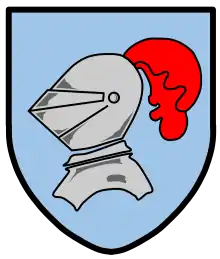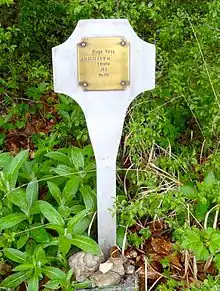Jagdgeschwader 4
Jagdgeschwader 4 (JG 4) was a Luftwaffe fighter wing of World War II.
| Jagdgeschwader 4 | |
|---|---|
 | |
| Active | 1942–45 |
| Country | |
| Branch | Air Force |
| Type | Fighter Aircraft |
| Role | Air superiority |
| Size | Air Force Wing |
| Commanders | |
| Notable commanders | Gerhard Schöpfel (15.6.44 – 6.8.44) |
Sturmgruppen 1944
Jagdgeschwader 4 became one of only three Luftwaffe geschwader to operate the specialised 'bomber-killer' gruppen designated Sturmgruppe. II./JG 4 Sturmgruppe was formed on 12 July 1944 at Salzwedel from I./Zerstörergeschwader 1 (ZG 1) and from elements of Major Hans-Günter von Kornatzki's Sturmstaffel 1. The gruppe was equipped with the modified and heavily armoured FW 190A-8/R2. While the heavily armoured fighters proved effective against the heavy bombers of the USAAF, they proved vulnerable to the numerous escort fighters and hence suffered heavy losses.
III./JG 4 was also formed in July 1944 from III./ZG 1 in Rotenburg.
In common with other fighter units engaged in Reichsverteidigung operations the Geschwader were sported unique coloured rear fuselage banding markings in mid 1944, with differing color combinations unique to each wing. JG 4's marking was a black-white-black band on the rear fuselage.
On 11 September 1944 II.(Sturm)/JG 4 escorted by III. Gruppe intercepted a USAAF bombing raid near Chemnitz. Attacking the 100th and 95th Bomb Groups the Geschwader claimed some 13 destroyed bombers. Intercepted by the 339th and 55th Fighter Groups JG 4 was severely mauled, and lost 21 pilots killed and 9 more were seriously injured during the mission.
In October 1944 IV./JG 4 was formed from elements of II./JG 5 in Finsterwalde, equipped with the Messerschmitt Bf-109G and K.
On 2 November the Sturmgruppe, in conjunction with IV./JG 3, intercepted American bomber formations in the Leipzig area. II./JG 4 attacked the 457th Bombardment Group and destroyed nine B-17s, although the Gruppe lost 16 Fw 190s out of 22 committed to the massed US fighter escorts.

From November 1944 onwards the Geschwader, operating from Frankfurt took heavy losses flying against the Allied air offensive. Apart from for II.(Sturm)/JG 300, heavy losses meant the Sturmgruppen had virtually ceased to exist by late November 1944, and with the transfer to Babenhausen in December 1944 the remnants of II./JG 4 would carry out the same fighter and ground attack operations as their sister units for the rest of their existence, and would not claim another heavy bomber.[1] In early 1945 II. Gruppe re-equipped with the Focke Wulf Fw 190A-9 and later D-9 fighters.

During Operation Bodenplatte on 1 January 1945 JG 4, along with all other units taking part, again took very heavy losses. With 75 JG 4 aircraft tasked with various targets, including an attack on Le Culot Airfield, I., II. and IV. Gruppen were hit by heavy anti-aircraft fire and the massed formation became scattered and therefore impossible to co-ordinate an effective attack, with only 12 or so aircraft locating or attacking any intended objective. Overall, some 26 fighters were lost and 6 damaged; with nearly half the participating aircraft lost, JG 4 suffered the highest percentage losses of all the units taking part in the operation.[2]
By late January 1945 JG 4 was deployed in Guben-Jüterbog until the end of the war in May.
On 21 January 1945 the four Gruppen of JG 4 were switched to Luftlotte 6 on the Eastern Front and pitchforked wholesale into ground-attack missions, for which the unit was ill-equipped and pilots untrained. By early February 1945 II.(Sturm)/JG 4 were located at Neuhausen under Major Gerhard Schroeder in defence of Cottbus.
Although nearly 400 vehicles were claimed destroyed, losses during the month inevitably emasculated the unit, with some 57 aircraft lost, with 26 pilots killed or missing and 14 wounded.[3]
I./JG 4 was dissolved during March 1945 and the remustering of the unit personnel as infantry followed. Elements of JG 4 flew their last sorties against the Soviet armies and air forces around Berlin and in late April 1945 the unit withdrew to the Schleswig-Holstein area and disbanded on 8 May 1945.
Insignia
Some JG 4 aircraft displayed on the engine cowling the Geschwaderzeichen, a blue escutcheon with a grey or silver knight’s helmet with a red (red-white) plume.
This insignia was first used by II. Gruppe, but later also appeared on other JG 4 Gruppen aircraft.
Commanding officers
Geschwaderkommodore
- Major Gerhard Schöpfel, 15 June 1944 – 6 August 1944
- Oberstleutnant Gerhard Michalski, 7 August 1944 – 8 May 1945
I./JG 4
- Hauptmann Franz Hahn, 10 January 1943 – 22 January 1944
- Hauptmann Wilhelm Steinmann, 23 January 1944 – 14 February 1944
- Hauptmann Walter Hoeckner, 15 February 1944 – 25 August 1944
- Hauptmann Wilhelm Steinmann, 26 August 1944 – March 1945
II./JG 4
- Oberstleutnant Hans-Günter von Kornatzki, 12 July 1944 – 12 September 1944
- Major Rudolf Schröder, 13 September 1944 – March 1945
- Major Wilhelm Moritz, March 1945 – 8 May 1945
III./JG 4
- Hauptmann Friedrich Eberle, 12 July 1944 – 8 January 1945
- Hauptmann Gerhard Strasen, 9 January 1945 – 8 May 1945
IV./JG 4
- Hauptmann Franz Wienhusen, 20 October 1944 – 3 December 1944
- Hauptmann Ernst Laube, 19 December 1944 – 3 April 1945
Notes
- Weal 2005, p. 106.
- Manrho & Pütz 2004, p. 188.
- Price 1991, p. 142.
References
- Boog, Horst; Krebs, Gerhard; Vogel, Detlef (2006). Germany and the Second World War: Volume VII: The Strategic Air War in Europe and the War in the West and East Asia, 1943-1944/5. Clarendon Press. ISBN 978-0-19-822889-9.
- Caldwell, Donald; Muller, Richard (2007). The Luftwaffe Over Germany: Defense of the Reich. MBI Publishing. ISBN 978-1-85367-712-0.
- Caldwell, Donald L. (1996). The JG 26 War Diary: 1939–1942. Vol. I. London: Grub Street. ISBN 978-1-898697-52-7.
- Campion, Garry (2015). The Battle of Britain, 1945-1965: The Air Ministry and the Few. London: Palgrave Macmillan. ISBN 978-1349574155.
- Eriksson, Patrick G. (2014). Alarmstart: The German Fighter Pilot's Experience in the Second World War: Northwestern Europe – from the Battle of Britain to the Battle of Germany. Amberley Publishing. ISBN 978-1445694399.
- Foreman, John (1993). Air War 1941: The Turning Point: Part One: The Day by Day Account of Air Operations Over Northwest Europe: From the Battle of Britain to the Blitz. Air Research Publications. ISBN 978-1-871187-22-9.
- Franks, Norman (1994). The Battle of the Airfields: 1 January 1945. London: Grub Street. ISBN 1-898697-15-9.
- Franks, Norman (2000). Royal Air Force Losses of the Second World War: Operational Losses: Aircraft and crews 1944–1945 (incorporating Air Defence Great Britain and 2nd TAF). Vol. III. Midland. ISBN 978-1-85780-093-7.
- Franks, Norman (2006). Air Battle for Dunkirk, 26 May - 3 June 1940. London: Grub Street. ISBN 1-904943-43-8.
- Hinsley, Harry (1988). British Intelligence in the Second World War. Volume 3, Part 2: Its Influence on Strategy and Operations. London: Her Majesty's Stationery Office (HMSO). ISBN 0-11-630940-7.
- Hooton, E.R. (1999). Eagle in Flames: Defeat of the Luftwaffe. Weidenfeld & Nicolson. ISBN 978-1-85409-343-1.
- Manrho, John; Pütz, Ron (2004). Bodenplatte: The Luftwaffe's Last Hope, The Attack on Allied Airfields New Year's Day 1945. Hikoki. ISBN 978-1-902109-40-4.
- Mombeek, Eric (2002). Chasseurs d'assaut: l'histoire de la Jagdgeschwader 4. Lela presse. ISBN 2-91401-710-3.
- Muller, Richard (1992). The German Air War in Russia. New York City: Nautical & Aviation Pub Co of America. ISBN 978-1-877-85313-5.
- Murray, Williamson (1983). Strategy for Defeat: The Luftwaffe 1933–1945. Maxwell AFB: Air University Press. ISBN 978-1-58566-010-0.
- National Archives (Air Ministry Narratives) (2001). The Rise and fall of the German Air Force: 1933-1945. London: The National Archives (United Kingdom). ISBN 978-1-903365-30-4.
- Parker, Danny S. (1998). To Win The Winter Sky: The Air War Over the Ardennes, 1944–1945. Da Capo. ISBN 978-1-58097-006-8.
- Price, Alfred (1991). The Last Year of the Luftwaffe, May 1944 to May 1945. Arms & Armour. ISBN 978-1-85409-189-5.
- Prien, Jochen; Rodeike, Peter (1994). Jagdgeschwader 1 und 11: Einsatz in der Reichsverteidigung von 1939 bis 1945: Teil 1, 1939–1943 [Jagdgeschwader 1 and 11: Operations in the Defense of the Reich from 1939 to 1945] (in German). Vol. I 1939–1943. Eutin, Germany: Struve-Druck. ISBN 978-3-923457-21-2.
- Prien, Jochen; Rodeike, Peter (1996a). Jagdgeschwader 1 und 11—Einsatz in der Reichsverteidigung von 1939 bis 1945—Teil 2—1944 [Jagdgeschwader 1 and 11—Operations in the Defense of the Reich from 1939 to 1945—Volume 2—1944] (in German). Eutin, Germany: Struve-Druck. ISBN 978-3-923457-24-3.
- Prien, Jochen; Rodeike, Peter (1996b). Jagdgeschwader 1 und 11—Einsatz in der Reichsverteidigung von 1939 bis 1945: Teil 3, 1944–1945 [Jagdgeschwader 1 and 11—Operations in the Defense of the Reich from 1939 to 1945] (in German). Vol. III 1944–1945. Eutin, Germany: Struve-Druck. ISBN 978-3-923457-25-0.
- Prien, Jochen; Stemmer, Gerhard; Rodeike, Peter; Bock, Winfried (2003). Die Jagdfliegerverbände der Deutschen Luftwaffe 1934 bis 1945—Teil 5—Heimatverteidigung—10. Mai 1940 bis 31 Dezember 1941—Einsatz im Mittelmeerraum—Oktober 1940 bis November 1941—Einsatz im Westen—22. Juni bis 31. Dezember 1941—Die Ergänzungsjagdgruppen—Einsatz 1941 bis zur Auflösung Anfang 1942 [The Fighter Units of the German Air Force 1934 to 1945—Part 5—Defense of the Reich—10 May 1940 to 31 December 1941—Action in the Mediterranean Theater—October 1940 to November 1941—Action in the West—22 June to 31 December 1941—The Supplementary Fighter Groups—Action from 1941 until their Breakup in Early 1942] (in German). Eutin, Germany: Struve-Druck. ISBN 978-3-923457-68-7.
- Prien, Jochen; Stemmer, Gerhard; Rodeike, Peter; Bock, Winfried (2004). Die Jagdfliegerverbände der Deutschen Luftwaffe 1934 bis 1945—Teil 7—Heimatverteidigung—1. January bis 31 Dezember 1942—Einsatz im Westen—1. Januar bis 31. Dezember 1942 [The Fighter Units of the German Air Force 1934 to 1945—Part 7—Defense of the Reich—1 January to 31 December 1942—Action in the West—1 January to 31 December 1942] (in German). Eutin, Germany: Struve-Druck. ISBN 978-3-923457-73-1.
- Schuelke, John (October 1995). "A Fighter Group in Normandy". Luftwaffe Verband Journal. IV (October 1995).
- Shores, Christopher; Foreman, John; Ehrengardt, Chris (1992). Fledgling Eagles. London, UK: Grub Street. ISBN 978-0-948817-42-7.
- Shores, Christopher; Thomas, Chris (2006). 2nd Tactical Air Force: From the Rhine to Victory: January to May 1945. Vol. III. Classic. ISBN 978-1-903223-60-4.
- Stedman, Robert (2002). Luftwaffe Air & Ground Crew 1939–45. Men at Arms 377. illustrated by Mike Chappell. Oxford: Osprey. ISBN 1-84176-404-3.
- Sundin, Claes; Bergström, Christer (2002). More Luftwaffe Fighter Aircraft in Profile. Schiffer. ISBN 978-0-7643-1559-6.
- Weal, John (2006). Bf 109 Defence of the Reich Aces. Aircraft of the Aces 68. Osprey. ISBN 978-1-84176-879-3.
- Weal, John (2010). Fw 190 Defence of the Reich Aces. Aircraft of the Aces 9. Osprey. ISBN 978-1846034824.
- Weal, John (1996). Focke-Wulf Fw 190 Aces of the Western Front. Osprey. ISBN 1855325950.
- Weal, John (2003). Jagdgeschwader 27 'Afrika'. London, UK: Osprey Publishing. ISBN 978-1-84176-538-9.
- Weal, John (2005). Luftwaffe Sturmgruppen. London, UK: Osprey Publishing. ISBN 978-1841769080.
- Weal, John (1999). Bf 109 F/G/K Aces of the Western Front. London, UK: Osprey Publishing. ISBN 978-1855329058.